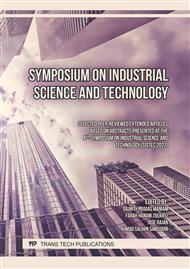[1]
C. Lin, S. Kuo, and H. Chuang. (2005). A 2.4 GHz Printed Meander Line Antenna for USB WLAN With Notebook-PC Housing. IEEE Microw. Wirel. Components Lett.(15):546–548.
DOI: 10.1109/lmwc.2005.855387
Google Scholar
[2]
M. T. Sebastian. (2008) Dielectric material for wireless communication. London: Elsevier.
Google Scholar
[3]
N. Feiz, F. Mohajeri, and D. Zarifi. (2014). Design, Simulation and Fabrication of an Optimized Microstrip Antenna with Metamaterial Superstrate Using Particle Swarm Optimization. Progress In Electromagnetics Research M. (36):101–108
DOI: 10.2528/pierm14010202
Google Scholar
[4]
T. Rihayat, Suryani and Zaimahwati. (2014). Preparation and properties and application of renewable source (palm oil polyol) based polyurethanes coatings and its thermal stability improvement by clay nanocomposites. Advanced Materials Research. (888):566–569.
DOI: 10.4028/www.scientific.net/amr.887-888.566
Google Scholar
[5]
M. Z Arniza, S.S Hoong, Z. Idris , S.K Yeong, H.A Hassan, A.K Din, Y.M Choo. (2015). Synthesis of transesterified palm olein-based Polyol and rigid polyurethanes from this polyol. JAOCS, J. Am. Oil Chem. Soc. (92):243–255.
DOI: 10.1007/s11746-015-2592-9
Google Scholar
[6]
S. Rajesh, K.P Murali, J. Heli and R. Ravendran. (2011). The effect of filler on the temperature coefficient of the relative permittivity of PTFE / ceramic composites. Phys. B Phys. Condens. Matter.vol. (406): 4312–4316.
DOI: 10.1016/j.physb.2011.08.080
Google Scholar
[7]
S. N. S. Mahmud, M.A Jusoh, K.Y You, N. Salim, S. Shaheen, A.G.E Sutjipto. (2017). "Structural and Dielectric Properties of Polyurethane Palm Oil Based Filled Empty Fruit Bunch. Int. J. Adv. Eng. Res. Sci. (6495): 259–264.
DOI: 10.22161/ijaers.4.1.42
Google Scholar
[8]
S. N. S. Mahmud, M.A Jusoh, S.E Jasim, A.H Zamani and M.H Abdullah. (2018). Design, simulation and analysis a microstrip antenna using PU-EFB substrate. IOP Conf. Series: Materials Science and Engineering 342. 012-021.
DOI: 10.1088/1757-899x/342/1/012021
Google Scholar
[9]
A. Irianto, B. Mutiara, and Rachmansyah. (2011). Designing and Manufacturing Microstrip Antenna for Wireless Communication at 2.4 GHz. Int. J. Comput. Electr. Eng. (3): 1–6.
DOI: 10.7763/ijcee.2011.v3.401
Google Scholar
[10]
Z. Awang, N.M. Affendi, N.L Alias and N.M Razali. (2016). Flexible Antennas Based on Natural Rubber. Prog. Electromagn. Res. C (61): 75–90.
DOI: 10.2528/pierc15092501
Google Scholar
[11]
S. Sankaralingam and B.Gupta. (2010). Development of Textile Antennas For Body Wearable Applications And Investi0gations On Their Performance Under Bent Conditions. Prog. Electromagn. Res. B. (22): 53–71.
DOI: 10.2528/pierb10032705
Google Scholar



